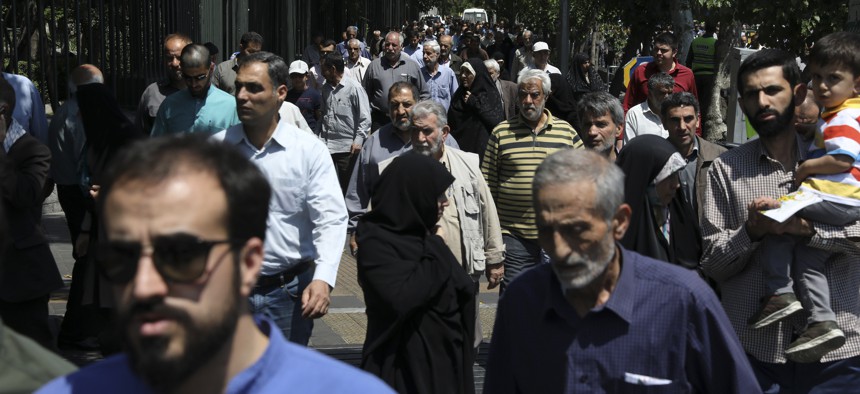
In this Friday, May 17, 2019 photo, worshippers leave at the conclusion of Friday prayers in downtown Tehran, Iran. AP Photo/Vahid Salemi
How Is Iran Worse Than Saudi Arabia?
A rational foreign policy would view Tehran as a normal regional power jockeying with equally sharp-elbowed foes. 2020 Democrats can lead the way.
With ideas like Medicare for All and the Green New Deal, the 2020 Democratic presidential contenders are challenging the ideological parameters that have defined American domestic policy since the Reagan era. If only they were doing so on foreign policy too.
Consider their responses to President Donald Trump’s recent escalation with Iran. Yes, one Democrat after another has called on Congress to prevent Trump from going to war. But Democrats have not frontally challenged the core assumption underlying Trump’s belligerence: that Iran is a uniquely malevolent actor in the Middle East.
Even as he criticized Trump’s recent actions, Representative Seth Moulton last week called Iran “a major threat to our national security.” In a statement emailed by her staff, Kirsten Gillibrand condemned its “malign activities.” Cory Booker has in the past insisted that the United States “be more vigilant than ever in fighting Iranian aggression.”
By echoing the GOP’s confrontational language, these Democrats are forgetting a crucial lesson of the Iraq War. America didn’t invade Baghdad only because people like John Bolton misrepresented intelligence on weapons of mass destruction. America invaded because, under both Bill Clinton and George W. Bush, Democrats and Republicans so inflated the threat from Saddam Hussein that restoring normal economic and diplomatic relations with his regime became politically impossible. The result was a web of sanctions that no administration could lift, and a glide path to war.
Ever since the 1979 Iran hostage crisis, Americans have held an understandably negative view of the Iranian regime, a public perception that makes it easy for Trump, Bolton, and Secretary of State Mike Pompeo to describe it as the root of virtually all of the Middle East’s ills. But, in truth, Iran today is no more aggressive and malign than its key regional competitor, and America’s ally, Saudi Arabia.
Compare the two governments’ behavior across a host of domains. First, military spending. In 2017, according to the International Crisis Group, Riyadh spentroughly four times as much on defense as did Tehran. That’s nothing new. According to the Stockholm International Peace Research Institute, Iran hasn’t spent more than 3.3 percent of its GDP on defense in any year since 1989. During that period, the Saudis have spent at least 7 percent every single year. Saudi weaponry is also far better. According to a 2015 report by the Center for Strategic and International Studies, Riyadh and its Gulf allies “have acquired and are acquiring some of the most advanced and effective weapons in the world,” while “Iran has essentially been forced to live in the past, often relying on systems originally delivered at the time of the Shah, or lower grade imports, many of which reflect the technologies of the 1960s to 1980s.” Factor in Israel—the Middle East’s preeminent military power—as another counterweight to Iran, and the claim that Tehran threatens to dominate the Middle East becomes even more absurd.
Related: Trump’s ‘Maximum Pressure’ Won’t Make Iran Yield
Related: The Partisan Divide on How to Read the Intelligence on Iran
Related: Saudi Arabia Is Hurting American Interests
A second supposed example of Iran’s uniquely aggressive behavior is its intervention in Syria. But here, again, Tehran’s behavior is no more aggressive than Riyadh’s.
The key to understanding Iran’s involvement in Syria is the Iraq-Iran War. In 1980, Saddam invaded Iran in what became one of the longest and bloodiest conflicts of the late 20th century. Roughly 1 million Iranians died. And although Saddam was clearly the aggressor, and even after he used chemical weapons, almost every major Arab country—plus the United States—backed him.
Only one Arab government took Iran’s side: Syria. It has remained Iran’s lone consistent regional ally ever since. It’s not surprising, therefore, that when protests broke out against Bashar Assad’s government in 2011, Iran feared his replacement by either pro-American forces committed to regime change in Tehran or Sunni Islamists virulently hostile to Iran’s brand of Shia Islam. Like Turkey, Iran also feared if Syria’s Kurds seceded that might embolden Kurdish separatists in their country.
None of this justifies Iran’s complicity in Assad’s murderous repression. But in Syria, Iran isn’t promoting revolution. It’s defending a brutal status quo, just as Riyadh did when it sent troops to repress protests by Bahrain’s Shia majority in 2011 or when it backed Egyptian General Abdel Fattah el-Sisi’s bloody crackdown against supporters of the Muslim Brotherhood following his 2014 coup. In Syria, it’s not the Iranians who have been promoting regime change. It’s Saudi Arabia and its Gulf allies, which have backed a host of anti-Assad rebel groups, including some linked to Jabhat al-Nusra, Al Qaeda’s local affiliate.
The third example of Iran’s supposedly destabilizing behavior is Yemen, where it has given aid and training to Houthi rebels who now control the western part of the country. But there, too, Iran is engaged in the same kind of realpolitik practiced by America’s friends. In Syria, the Saudis have tried to overthrow Iran’s ally. In Yemen, where the Houthis overthrew a Saudi ally, former President Abdrabbuh Mansur Hadi, Iran is returning the favor. Iran sees Yemen as the Saudis’ Vietnam, and as CIA veteran Paul Pillar has explained, they’re happy to see their regional foe “bleed.”
Moreover, as the Vietnam analogy suggests, the outside power that’s wreaking the most havoc in Yemen isn’t Tehran. It’s Riyadh, which, along with the United Arab Emirates has blockaded Yemen’s ports and bombed its people, and thus fueled the worst humanitarian crisis in the world.
The final charge against Iran is that it ranks, in the Trump administration’s oft-repeated phrase, as “the leading state sponsor of terror.” Iran certainly supports terrorist groups: including Hezbollah, Palestinian Islamic Jihad, and Hamas. (Which has also received backing from U.S. allies like Qatar and Turkey). And it likely played a role in Hezbollah’s attack on the American embassy in Beirut in 1983 and an apartment complex housing U.S. Air Force personnel in Saudi Arabia in 1996.
But the problem with suggesting that Iranian is uniquely supportive of terrorism is that, in recent decades, Sunni jihadist groups like ISIS and Al Qaeda have killed far more American civilians. And those groups have received the bulk of their state support not from Iran but from Sunni-led regimes—particularly Saudi Arabia and other monarchies in the Gulf. In 2016, Americans learned that a long-classified section of the 9/11 Commission Report alleged that, “While in the United States, some of the September 11 hijackers were in contact with, and received support or assistance from, individuals who may be connected to the Saudi Government.” Earlier this year, CNN reported that Saudi Arabia and the UAE have transferred American-made weapons to Al Qaeda fighters in Yemen.
Saudi and Emirati misdeeds don’t excuse Iran’s. But they underscore the problem with calling Iran reckless, revolutionary, imperial, or destabilizing without describing its American-backed rivals in the same way. In contrast to Trump, Bolton, and Pompeo, security professionals generally describe Iran’s foreign policy as opportunistic but cautious. A 2014 Pentagon report argued that, “Iran’s military doctrine is defensive.” In 2012, the chairman of the Joint Chiefs of Staff, Martin Dempsey, called the Iranian regime a “rational actor,” an assessment echoed by Benny Gantz, then-head of the Israeli Defense Forces, and former Israeli spy chief Meir Dagan.
The Democrats running for president need to say this too. They need to say it because only by challenging the Trump administration’s description of Iran as singularly irrational and menacing can Democrats justify the normalization of relations with Tehran. And without such a normalization, the prospect of war, which flared this week, will return again and again.
By calling out Iranian aggression while ruling out war, Democrats may believe they’re splitting the difference. But if they can’t describe Iran as a normal regional power jockeying with equally sharp-elbowed foes, they can’t effectively challenge the sanctions the Trump administration keeps piling on the Islamic Republic. Over time, permanent sanctions can become a formula for military conflict.
This is a key, if underappreciated, lesson of Iraq. In the 1990s, sanctions on that country devastated the Iraqi people but, as the academic research on sanctions would have predicted, they actually helped Saddam entrench his rule. Over time, as usually happens, their enforcement also began to fray. And because rapprochement with Saddam was unthinkable, the fear that his regime might eventually escape sanctions led Bill Clinton to make regime change official U.S. policy in 1998. Clinton never contemplated an all-out invasion. But the impossibility of normalization—because of the bipartisan exaggeration of the threat Saddam posed—put the U.S. and Iraq on a path to war.
That’s what the Trump administration is doing now with Iran. It hasn’t just re-imposed the economic sanctions that Obama lifted. It has toughened them, and imposed conditions—which include Tehran’s withdrawal from every major country in which it is competing with Riyadh—that Iran can never meet. As in Iraq, those sanctions will cause many innocent people to die. Petrified of provoking America’s wrath, foreign businesses and banks are already refusing to facilitate the sale to Iran of life-saving medicines. But, as in Iraq, the sanctions will likely fail to topple the regime. “As I witnessed during the last round of sanctions,” wrote The Washington Post’s Jason Rezaian last year, after emerging from an Iranian prison, “when people are squeezed economically, their needs and aspirations become much more about survival than about working toward change.”
Worse still, by denying Iran any of the economic benefits it was promised in the nuclear deal, the Trump administration is goading it into restarting its nuclear program, which could provide the U.S. and Israel a pretext to strike. By trying to ensure that Iran cannot export a single barrel of oil, and relying on Saudi Arabia and other Gulf countries to meet global demand, the Trump administration is goading Tehran into interfering with their exports. And last month the Trump administration designated Iran’s Revolutionary Guards Corps a terrorist organization, even after U.S. military officials warned that it increased the prospect of Iranian retaliation.
That’s the crucial context behind last week’s war scare: The Trump administration was responding to a provocation it helped create. As former Bush administration national security official Kori Schake told The New York Times, “Every single European government believes that the increased threat we’re seeing from Iran now is a reaction to the United States … They believe that the U.S. is the provocateur and they worry that the U.S. is reacting so stridently to predictable Iranian actions in order to provide a pretext for a U.S. attack on Iran.”
It’s not enough for the Democratic presidential candidates to resist this latest brush with war. It’s not even good enough for them to pledge to return to the Iran nuclear deal, because the deal won’t survive unless Iran is reintegrated into the world economy and receives the sanctions relief it was promised. Unless Democrats challenge the notion that Iran is uniquely malevolent they won’t be able to call for a normalization of relations with the United States. And unless Democrats call for a normalization of relations, a hot war will remain an ever-present danger.
On domestic policy, Democrats have realized that some of America’s biggest problems can’t be solved unless they leave old ideological limitations behind. That’s true for foreign policy too.





